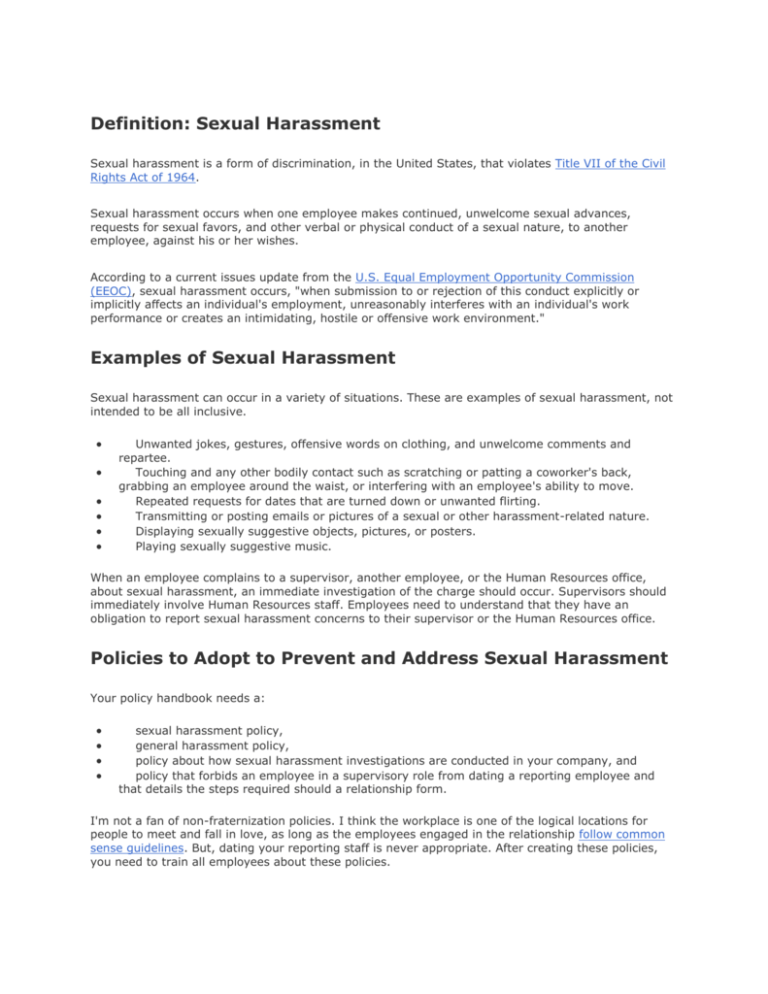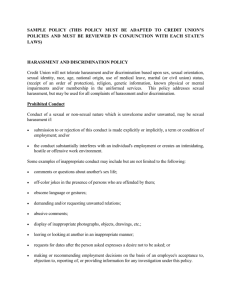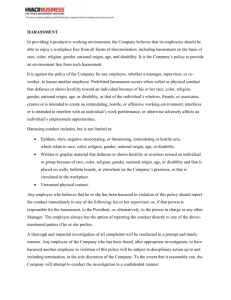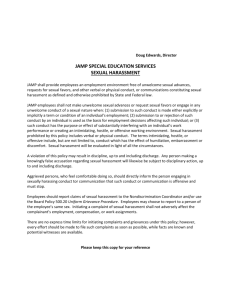
Definition: Sexual Harassment
Sexual harassment is a form of discrimination, in the United States, that violates Title VII of the Civil
Rights Act of 1964.
Sexual harassment occurs when one employee makes continued, unwelcome sexual advances,
requests for sexual favors, and other verbal or physical conduct of a sexual nature, to another
employee, against his or her wishes.
According to a current issues update from the U.S. Equal Employment Opportunity Commission
(EEOC), sexual harassment occurs, "when submission to or rejection of this conduct explicitly or
implicitly affects an individual's employment, unreasonably interferes with an individual's work
performance or creates an intimidating, hostile or offensive work environment."
Examples of Sexual Harassment
Sexual harassment can occur in a variety of situations. These are examples of sexual harassment, not
intended to be all inclusive.
Unwanted jokes, gestures, offensive words on clothing, and unwelcome comments and
repartee.
Touching and any other bodily contact such as scratching or patting a coworker's back,
grabbing an employee around the waist, or interfering with an employee's ability to move.
Repeated requests for dates that are turned down or unwanted flirting.
Transmitting or posting emails or pictures of a sexual or other harassment-related nature.
Displaying sexually suggestive objects, pictures, or posters.
Playing sexually suggestive music.
When an employee complains to a supervisor, another employee, or the Human Resources office,
about sexual harassment, an immediate investigation of the charge should occur. Supervisors should
immediately involve Human Resources staff. Employees need to understand that they have an
obligation to report sexual harassment concerns to their supervisor or the Human Resources office.
Policies to Adopt to Prevent and Address Sexual Harassment
Your policy handbook needs a:
sexual harassment policy,
general harassment policy,
policy about how sexual harassment investigations are conducted in your company, and
policy that forbids an employee in a supervisory role from dating a reporting employee and
that details the steps required should a relationship form.
I'm not a fan of non-fraternization policies. I think the workplace is one of the logical locations for
people to meet and fall in love, as long as the employees engaged in the relationship follow common
sense guidelines. But, dating your reporting staff is never appropriate. After creating these policies,
you need to train all employees about these policies.
The Role of Managers in Harassment Prevention and
Investigation
Managers and supervisors are the front line when it comes to managing employee performance and
needs from work. First, and most importantly, you do not want a workplace culture that allows any
form of harassment to occur. Out of your commitment to your employees and your company,
harassment, in any form, is never to be tolerated.
In harassment, as well as in other law suit-engaging topics, as an employer, demonstrating that you
took appropriate steps is crucial. In fact, demonstrating that you took immediate action and that the
consequences for the perpetrator were severe, is also critical. And, the front line leader is usually the
person initiating and following through on those steps, so they have to feel confident about what they
are doing. Any form of harassment can create a hostile work environment including sexual harassment
and how it is addressed. The court's definition of what constitutes a hostile work environment has
recently expanded to coworkers who are caught up in the situation, too.
As you think about sexual harassment and other forms of harassment in your work place, keep these
facts in mind.
The employee harassing another employee can be an individual of the same sex. Sexual
harassment does not imply that the perpetrator is of the opposite sex.
The harasser can be the employee's supervisor, manager, customer, coworker, supplier, peer,
or vendor. Any individual who is connected to the employee's work environment, can be accused
of sexual harassment.
The victim of sexual harassment is not just the employee who is the target of the harassment.
Other employees who observe or learn about the sexual harassment can also be the victims and
institute charges. Anyone who is affected by the conduct can potentially complain of sexual
harassment. As an example, if a supervisor is engaged in a sexual relationship with a reporting
staff member, other staff can claim harassment if they believe the supervisor treated his or her
lover differently than they were treated.
In the organization's sexual harassment policy, advise the potential victims that, if they
experience harassment, they should tell the perpetrator to stop, that the advances or other
unwanted behaviors are unwelcome.
Sexual harassment can occur even when the complainant cannot demonstrate any adverse
affect on his or her employment including transfers, discharge, salary decreases, and so on.
When an individual experiences sexual harassment, they should use the complaint system and
recommended procedures as spelled out in the sexual harassment policy of their employer. The
investigation should be conducted as spelled out in the handbook.
The employer has the responsibility to take each complaint of sexual harassment seriously and
investigate. The investigation should follow these steps listed in How to Address Sexual
Harassment Charges.
Following the investigation of the harassment complaint, no retaliation is permitted, regardless
of the outcome of the investigation. The employer must, in no way, treat the employee who filed
the complaint differently than other employees are treated nor change his or her prior-to-thecomplaint treatment. If it is determined that the employee lied, disciplinary action is necessary,
however.
When an employee complains that he or she is experiencing sexual harassment of any type, the
employer has a legal, ethical, and employee relations obligation to thoroughly investigate the charges.
Here's How:
1.
Before a complaint is filed, make sure you have posted and informed all employees of your
organization’s policy relative to sexual harassment. It won’t be tolerated; it will be investigated.
2.
Assign a staff member to “own” the complaint. This individual should be knowledgeable about
the organization, the people in the organization, and the history of the organization.
3.
Map out a plan that covers the important people and situations to investigate in the initial
complaint. Basically, plan the investigation, based on current knowledge.
4.
Talk with the employee who is complaining. Guarantee to the employee that he or she is safe
from retaliation and took appropriate action in reporting the incident or general situation.
5.
Inform the employee that you need to know immediately about any retaliation, purported
retaliation, or ongoing harassment the employee experiences.
6.
Ask the employee to tell you the whole story in his or her own words. Listen; take notes. Write
down relevant facts such as dates, times, situations, witnesses, and anything else that seems
relevant.
7.
Tell the person accused that a complaint has been filed, and that no acts of retaliation or
unethical actions will be tolerated. Ask the person to be patient while you conduct a thorough
investigation.
8.
Assure the person accused that a fair and just investigation will be conducted on their behalf
as well as that of the accuser.
9.
Interview any potential witnesses in the same manner. Interview any potential witnesses in
the same manner. Ask open-ended questions and seek facts that support or disprove the
employee’s allegations.
10.
Interview the person who is accused of sexual harassment. Apply the same listening and
respectful approach you accorded the person who filed the complaint and the other witnesses.
11.
Take all the information you received and attempt to reach a decision. Make the best decision
that you can with the information you have. Consult with other HR colleagues to do the right
thing.
12.
Make decisions about whether sexual harassment occurred. Provide the appropriate discipline
to the appropriate people, based on your findings. Make work or assignment setting adjustments
if necessary.
13.
Recognize that you are not perfect, no situation can be perfectly investigated. Even when
harassment may have occurred, there may be no facts or witnesses that corroborate a
complainant’s statement.
14.
Assure that no further incidents occur by following up, and documenting your follow-up. with
the employee who made the original harassment claim. Keep documentation separate from the
personnel file.
15.
Afford the employee, who may have been wrongly accused, the same courtesy of follow-up
and documentation. Adjust working situations fairly where necessary for the comfort and
productivity of all.
Tips:
1.
Legally, the employer will want to avoid any possibility or appearance that the employee’s
complaint was disregarded. Respond immediately.
2.
Ethically, the employer will not want to allow such behavior to exist in their workplace.
3.
The trust, morale, and fair treatment of employees is at stake. An employer’s actions send
powerful signals about what another employee can expect in similar circumstances.
4.
You may want to consider reposting and reiterating your sexual harassment policies across
your whole work place. Let the circumstances guide your judgment.
5.
In all cases, make sure you make and keep complete and accurate documentation. Employees
who are unhappy with the results of your investigation may take additional legal action.










